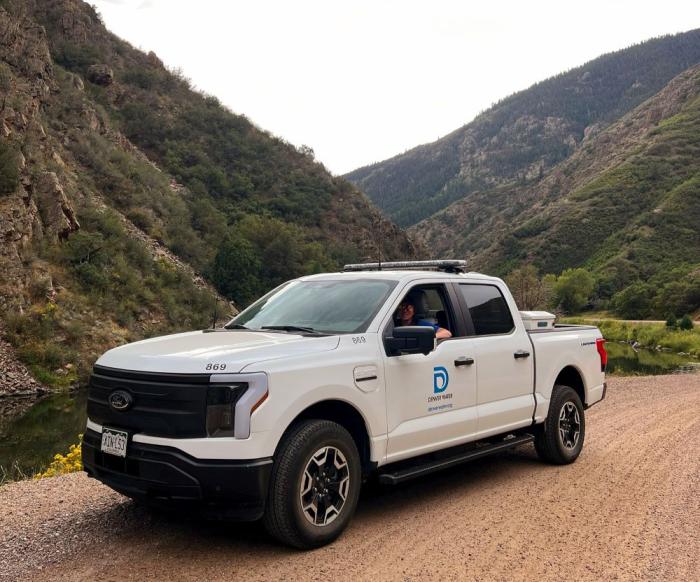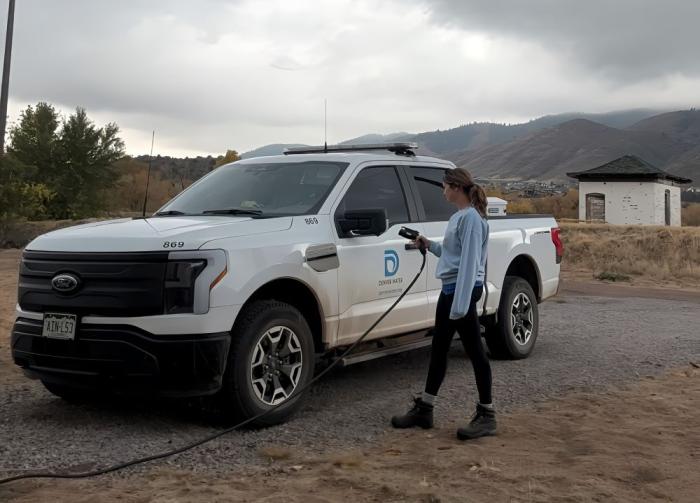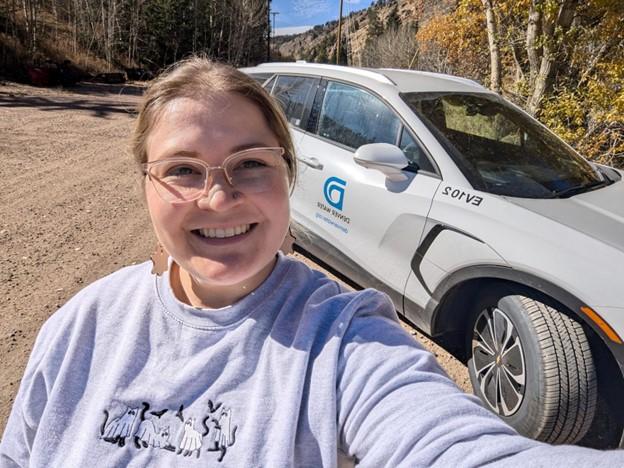Denver Water’s fleet gets the juice
Denver Water’s relentless efforts to become a more sustainable water utility have zipped around yet another corner: Its first set of electric vehicles have arrived and are in the field.
The first batch, seven Ford F-150 Lightning pick-ups and three Chevy Blazers, joined Denver Water’s vehicle fleet this summer and already utility workers are folding them into everyday use around the region.
The vehicles are part of Denver Water’s broader strategy to address climate change, including efforts to make facilities more energy efficient and to increase the use of renewable energy.
Most recently, the utility set and surpassed a goal to cut annual energy usage by 1 million kilowatt-hours.
By the end of 2024, the utility’s fleet of 760 vehicles, machinery and trailers is expected to include 16 EVs, with the pending arrival of additional F-150s and Blazers.
They’ll be used around town and in locations farther afield, including for trips up and down rugged Waterton Canyon southwest of Denver and out and about at Ralston Reservoir north of Golden.
The early reviews on Denver Water’s first batch of electric-powered vehicles are strong, with the vehicles showing impressive range, power and speed.
Learn more about Denver Water’s sustainability goals.
“The vehicles are performing extremely well and are a particularly good addition for some of our recreation areas, where visitors especially appreciate quiet, non-polluting vehicles,” said Brandon Ransom, Denver Water’s manager of recreation.
“It’s been a remarkably smooth transition from our fleet of gas-powered trucks.”
The new wheels will cut the utility’s carbon emissions that come from traditional vehicles powered by internal combustion engines. They also represent the latest step for Denver Water in its goal to cut the organization's greenhouse gas emissions 50% by 2025 from a 2015 baseline.
The vehicles are also expected to save Denver Water money, not only on gasoline costs that will be avoided, but through reduced maintenance and operating costs.
Total cost of ownership for both the F-150s and the Blazers will be less than if the utility had purchased new gasoline-powered vehicles. Savings are estimated to range from $6,000 to $9,000, figures that include the purchase price of the vehicle.
The first batch of EVs are considered a pilot approach for Denver Water.
They’ll give the utility a chance to gather data on how the vehicles perform in the field, their range in different environments and where they make the most sense to deploy in the utility’s fleet.
Sustainability officials at Denver Water call it a “phased approach,” rather than just setting a target for number of vehicles to replace with EVs.
“There’s a lot of excitement about the vehicles,” said Kate Taft, Denver Water’s manager of sustainability.
“We want to spend some time evaluating performance. Manufacturers are always going to give you a best-case scenario on something like range between charging. We want to pilot these vehicles and get real results that reflect the needs of our fleet,” she said.
That said, Denver Water is bullish on EVs and plans to expand its inventory in the years ahead as part of its increasingly ambitious climate goals.
An 2023 analysis conducted through a partnership with Xcel Energy and Sawatch Labs, a Denver company that evaluates vehicle fleet operations, concluded that Denver Water would benefit financially from switching out 63 of its light-duty vehicles with those powered by electricity. The study also found the change would cut emissions by nearly 1,100 tons of carbon dioxide emissions per year.
Electric vehicles are becoming more common, nationally and internationally, as manufacturers produce more, prices drop, charging infrastructure expands and consumers learn the vehicles perform well.
Electric car sales have risen gradually in the U.S. since 2020, according to market data.
”About 1.6 million EVs were sold in the U.S. in 2023 — a 60% increase from the 1 million sold nationwide in 2022,” according to a MarketWatch story published in September. “The U.S. accounted for 9.7% of all new EV registrations worldwide in 2022. Globally, EV sales topped 10 million for the first time in 2022.”
This fall, Denver Water recreation rangers began using a Ford F-150 Lightning to patrol the 6-mile road up and down Waterton Canyon, home to Strontia Springs Reservoir.
Ranger Danielle Compton said she was skeptical that the new vehicle would have the capabilities that she depends on for patrolling the area. Now, the truck is “her favorite” in her tenure at Denver Water.
“The truck is extremely powerful and never slips,” Compton said. “There are parts of the canyon where my tires would spin with a traditional truck, whereas this one can be stopped on an incline and start without struggle.”
Aside from a slew of benefits she cited with the electric vehicle, including its 350-mile battery range, Compton said participating in the shift to greater sustainability is the most important benefit to her. Members of the public exploring Waterton Canyon have noticed the vehicle and often ask about it.
“We are leading by example,” Compton said, “and showing an environmentally mindful approach does not mean sacrificing our ability to do the job right.”




